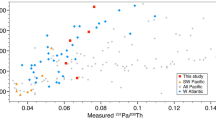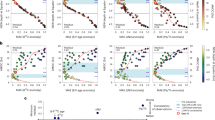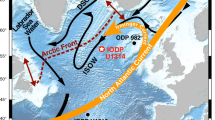Abstract
The Atlantic meridional overturning circulation affects the latitudinal distribution of heat, and is a key component of the climate system. Proxy reconstructions, based on sedimentary 231Pa/230Th ratios and the difference between surface- and deep-water radiocarbon ages, indicate that during the last glacial period, the overturning circulation was reduced during millennial-scale periods of cooling1,2,3,4,5. However, much debate exists over the robustness of these proxies6,7,8. Here we combine proxy reconstructions of sea surface and air temperatures and a global climate model to quantitatively estimate changes in the strength of the Atlantic meridional overturning circulation during the last glacial period. We find that, relative to the Last Glacial Maximum, the overturning circulation was reduced by approximately 14 Sv during the cold Heinrich event 1. During the Younger Dryas cold event, the overturning circulation was reduced by approximately 12 Sv, relative to the preceding warm interval. These changes are consistent with qualitative estimates of the overturning circulation from sedimentary 231Pa/230Th ratios. In addition, we find that the strength of the overturning circulation during the Last Glacial Maximum and the Holocene epoch are indistinguishable within the uncertainty of the reconstruction.
This is a preview of subscription content, access via your institution
Access options
Subscribe to this journal
Receive 12 print issues and online access
$259.00 per year
only $21.58 per issue
Buy this article
- Purchase on Springer Link
- Instant access to full article PDF
Prices may be subject to local taxes which are calculated during checkout




Similar content being viewed by others
References
Lynch-Stieglitz, J. et al. Atlantic meridional overturning circulation during the Last Glacial Maximum. Science 316, 66–69 (2007).
McManus, J. F., Francois, R., Gherardi, J-M. & Keigwin, L. D. Collapse and rapid resumption of Atlantic meridional circulation linked to deglacial climate changes. Nature 428, 834–837 (2004).
Gherardi, J. M. et al. Glacial–interglacial circulation changes inferred from Pa-231/Th-230 sedimentary record in the North Atlantic region. Paleoceanography 24, PA2204 (2009).
Lippold, J. et al. Strength and geometry of the glacial Atlantic Meridional Overturning Circulation. Nature Geosci. 5, 813–816 (2012).
Robinson, L. F. et al. Radiocarbon variability in the western North Atlantic during the last deglaciation. Science 310, 1469–1473 (2005).
Scholten, J. C. et al. Advection and scavenging: Effects on 230Th and 231Pa distribution off Southwest Africa. Earth Planet. Sci. Lett. 271, 159–169 (2008).
Keigwin, L. D. & Boyle, E. A. Did North Atlantic overturning halt 17,000 years ago? Paleoceanography 23, PA1101 (2008).
Lippold, J. et al. Does sedimentary 231Pa/230Th from the Bermuda rise monitor past Atlantic meridional overturning circulation? Geophys. Res. Lett. 36, L12601 (2009).
Ganachaud, A. & Wunsch, C. Improved estimates of global ocean circulation, heat transport and mixing from hydrographic data. Nature 408, 453–456 (2000).
Trenberth, K. & Caron, J. M. Estimates of meridional atmosphere and ocean heat transports. J. Clim. 14, 3433–3443 (2001).
NGRIP members. High-resolution record of Northern Hemisphere climate extending into the last interglacial period. Nature 431 147–151 (2004).
Schulz, H., von Rad, U. & Erlenkeuser, H. Correlation between Arabian Sea and Greenland climate oscillations of the past 110,000 years. Nature 393, 54–57 (1998).
Peterson, L. C., Haug, G. H., Hughen, K. A. & Röhl, U. Rapid changes in the hydrologic cycle of the tropical Atlantic during the last glacial. Science 290, 1947–1951 (2000).
Wang, Y. J. et al. A high-resolution absolute-dated Late Pleistocene monsoon record from Hulu Cave, China. Science 294, 2345–2348 (2001).
EPICA Community Members. One-to-one coupling of glacial climate variability in Greenland and Antarctica. Nature 444, 195–198 (2006).
Stocker, T. F. & Johnson, S. J. A minimum thermodynamic model for the bipolar seesaw. Paleoceanography 18, 1087 (2003).
Stocker, T. F. Past and future reorganizations in the climate system. Quat. Sci. Rev. 19, 301–319 (2000).
Hemming, S. R. Heinrich events: Massive late Pleistocene detritus layers of the North Atlantic and their global climate imprint. Rev. Geophys. 42, RG1005 (2004).
Broecker, W. S. Was the Younger Dryas triggered by a flood? Science 312, 1146–1148 (2006).
Barber, D. C. et al. Forcing of the cold event of 8,200 years ago by catastrophic drainage of Laurentide lakes. Nature 400, 344–348 (1999).
Ritz, S. P., Stocker, T. F. & Joos, F. A coupled dynamical ocean–energy balance atmosphere model for paleoclimate studies. J. Clim. 24, 349–375 (2011).
Masson-Delmotte, V. et al. EPICA Dome C record of glacial and interglacial intensities. Quat. Sci. Rev. 29, 113–128 (2010).
Menviel, L., Timmermann, A., Elison Timm, O. & Mouchet, A. Deconstructing the Last Glacial termination: The role of millennial and orbital-scale forcings. Quat. Sci. Rev. 30, 1155–1172 (2011).
Bozbiyik, A., Steinacher, M., Joos, F., Stocker, T. F. & Menviel, L. Fingerprints of changes in the terrestrial carbon cycle in response to large reorganizations in ocean circulation. Clim. Past 7, 319–338 (2011).
Jouzel, J. et al. Orbital and millennial Antarctic climate variability over the past 800,000 years. Science 317, 793–796 (2007).
Rayner, D. et al. Monitoring the Atlantic meridional overturning circulation. Deep Sea Res. II 58, 1744–1753 (2011).
Okazaki, Y. et al. Deepwater formation in the North Pacific during the last glacial termination. Science 329, 200–204 (2010).
Shakun, J. D. & Carlson, A. E. A global perspective on Last Glacial Maximum to Holocene climate change. Quat. Sci. Rev. 29, 1801–1816 (2010).
Enting, I. G. On the use of smoothing splines to filter CO2 data. J. Geophys. Res. 92, 10977–10984 (1987).
Acknowledgements
This study was financially supported by GRACCIE (CONSOLIDER-INGENIO 2010) and by the Swiss National Science Foundation. We thank F. Joos and C. Waelbroeck for fruitful discussions, M. Steinacher for providing the CSM data, and J. Jouzel for his help with the uncertainties of the ice core data.
Author information
Authors and Affiliations
Contributions
S.P.R. and T.F.S. developed the method, A.T. contributed with ideas on method verification and AMOC fingerprinting, S.P.R. performed the B3D simulations, L.M. provided the LVC simulation, J.O.G. provided support of the sediment core data, and S.P.R. and T.F.S. wrote the manuscript. All authors discussed the results and provided input on the manuscript.
Corresponding author
Ethics declarations
Competing interests
The authors declare no competing financial interests.
Supplementary information
Supplementary Information
Supplementary Information (PDF 1568 kb)
Supplementary Information
Supplementary Information (TXT 70 kb)
Rights and permissions
About this article
Cite this article
Ritz, S., Stocker, T., Grimalt, J. et al. Estimated strength of the Atlantic overturning circulation during the last deglaciation. Nature Geosci 6, 208–212 (2013). https://doi.org/10.1038/ngeo1723
Received:
Accepted:
Published:
Issue Date:
DOI: https://doi.org/10.1038/ngeo1723
This article is cited by
-
Multi-proxy constraints on Atlantic circulation dynamics since the last ice age
Nature Geoscience (2023)
-
Evolution characteristics of the Atlantic Meridional Overturning Circulation and its thermodynamic and dynamic effects on surface air temperature in the Northern Hemisphere
Science China Earth Sciences (2023)
-
The role of ocean and atmospheric dynamics in the marine-based collapse of the last Eurasian Ice Sheet
Communications Earth & Environment (2022)
-
Globally resolved surface temperatures since the Last Glacial Maximum
Nature (2021)
-
Enhanced vertical mixing in the glacial ocean inferred from sedimentary carbon isotopes
Communications Earth & Environment (2021)



